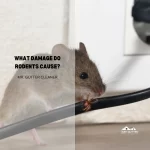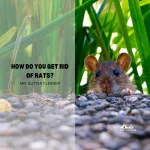Rodents, through their need to gnaw, cause significant damage to home structures, wiring, and plumbing, leading to costly repairs and potential health risks. These pests, including rats and mice, invade homes searching for food, water, and shelter, exploiting small openings to enter.
Once inside, their gnawing can compromise electrical systems, increasing the risk of fires, and damage wooden structures, weakening the integrity of homes.
Furthermore, rodents are vectors for diseases, contaminating food sources and surfaces with pathogens.
Their presence can also lead to allergies and asthma due to the accumulation of their droppings and dander.
Homeowners face financial burdens not only from the direct cost of repairs but also from potential increases in home insurance premiums due to the risks posed by infestations.
Preventative measures, including regular home maintenance and sealing entry points, are essential to mitigate these risks, emphasizing the importance of understanding and addressing rodent damage promptly.
Introduction
Understanding the scope and implications of rodent damage is essential for maintaining a safe and healthy home environment. Rodents, such as rats and mice, not only pose a threat to the structural integrity of homes but also carry diseases that can affect human health. By identifying the types of rodents that commonly invade homes, homeowners can better prepare and implement effective strategies to mitigate these risks.
Why Understanding Rodent Damage is Crucial for Homeowners?
Rodents cause extensive damage to homes by gnawing on electrical wires, plumbing, and structural components, leading to costly repairs. Beyond physical damage, the health risks associated with rodent infestations, including the spread of diseases and allergens, underscore the importance of prompt and effective rodent management.
Identifying Common Home-Invading Rodents
Common rodents that invade homes include Norway rats, roof rats, and house mice. Each species has unique behaviors and preferences for nesting, which influence the strategies homeowners should use for prevention and control.
Pathways of Rodent Entry into Homes
Rodents can enter homes through surprisingly small openings, exploiting any weaknesses in the home’s exterior. Understanding these entry points is crucial for homeowners to effectively seal their homes against rodent invasions.
How do Rats Get in Your House?
Rats exploit gaps in the exterior of homes, including openings around utility pipes, gaps in siding, and even through roof vents. Sealing these openings and maintaining the exterior of the home are critical steps in preventing rodent entry.
The Role of Poor Gutter Maintenance in Rodent Infestations
Poor gutter maintenance can lead to water damage and structural weaknesses that rodents exploit to gain entry into homes. Regular gutter cleaning and maintenance prevent water buildup and protect the home’s structural integrity, reducing potential rodent entry points.
Other Common Entry Points for Rodents
In addition to poorly maintained gutters, rodents commonly enter homes through cracks in foundations, spaces around doors and windows, and through chimneys. Implementing a thorough inspection and maintenance program to address these vulnerabilities can significantly reduce the risk of rodent infestation.
The Impact of Rodents on Home Structures
Rodents, such as rats and mice, pose significant risks to home structures by gnawing on various materials, leading to damage that compromises the integrity and safety of homes. They target electrical wiring, plumbing, and building materials, creating hazards and necessitating expensive repairs.
How Do Rodents Damage Electrical Wiring and Plumbing?
Rodents chew through electrical wiring and plumbing pipes, causing power outages, increasing the risk of electrical fires, and leading to water leaks. Their strong teeth can easily penetrate these materials, disrupting essential home services and creating safety risks.
What Structural Components Are Most Vulnerable to Rodent Damage?
Wooden structures, insulation, and ductwork are particularly susceptible to rodent damage. Rats and mice gnaw on these materials to sharpen their teeth and build nests, weakening the structural integrity of homes and reducing insulation efficiency.
The Effect of Rodents on Foundations and Roof Integrity
Rodents can burrow near foundations, leading to soil erosion and potential foundation cracks. Similarly, they can damage roofing materials while seeking entry points, leading to leaks and weakening the roof’s structural integrity.
Health Risks Posed by Rodents
Beyond structural damage, rodents present serious health risks to homeowners through the spread of diseases and allergens. Their presence in homes can lead to health complications for residents.
Understanding the Diseases Rodents Can Transmit
Rodents are carriers of various diseases, such as Hantavirus, leptospirosis, and salmonellosis, which they can transmit to humans through their droppings, urine, and saliva. Direct contact with these materials or inhalation of dust containing these pathogens can lead to serious health issues.
Financial Implications of Rodent Infestations
Rodent infestations can lead to significant financial burdens for homeowners, affecting both the immediate costs of eradication and the long-term expenses related to damage repair and prevention. Understanding these implications is crucial for effective home maintenance and financial planning.
Estimating the Costs of Repairing Damage Caused by Rodents
Repairing damage caused by rodents can be costly, involving the replacement of gnawed electrical wires, insulation, and structural components. The extent of the damage directly influences the repair costs, with more severe infestations leading to higher expenses. Additionally, the loss of personal property due to contamination or destruction adds to the financial impact.
The Impact of Rodent Infestations on Home Insurance Premiums
Homeowners’ insurance policies may cover some forms of rodent damage, but many do not include pest infestations. Consequently, homeowners often bear the full cost of eradication and repair. Moreover, frequent claims related to rodent damage can lead to increased premiums, further escalating the financial strain.
Preventative Measures Against Rodent Damage
Taking proactive steps to prevent rodent infestations is more cost-effective than addressing the consequences. Home maintenance plays a pivotal role in deterring rodents, safeguarding the home’s structural integrity, and maintaining a healthy living environment.
Strategies for Preventing Rodent Infestations
Regular home inspections and maintenance, including sealing cracks and openings, ensure rodents cannot enter. Removing food sources and clutter that may attract rodents also reduces the risk of infestation. Implementing these strategies effectively minimizes the likelihood of rodents invading the home.
Effective Rodent-Proofing Techniques for Homeowners
Rodent-proofing involves both structural modifications and behavioral changes. Installing metal screens over vents, using sealants to close gaps, and maintaining clean and organized storage areas are effective methods. Additionally, landscaping practices that limit rodent harborage near the home contribute to prevention efforts.
When to Seek Professional Pest Control Services
While many preventative measures can be implemented by homeowners, professional pest control services offer expertise in identifying and sealing potential entry points and providing targeted eradication solutions. Engaging professionals is particularly advisable when infestations persist or when homeowners are unsure of how to proceed effectively.
Addressing and Repairing Rodent Damage
After detecting rodent damage, homeowners should act swiftly to mitigate further destruction and prevent future infestations. Immediate and long-term strategies are essential for restoring home safety and integrity.
Immediate Actions to Take After Detecting Rodent Damage
Upon discovering signs of rodent damage, homeowners should first assess the extent of the destruction. This involves inspecting electrical wiring, plumbing, insulation, and structural components for signs of gnawing or contamination. Contacting professional pest control services for eradication and consulting with contractors for repair estimates are critical first steps.
Long-Term Repair and Prevention Strategies
After addressing the immediate damage, implementing long-term repairs and prevention measures ensures the home remains rodent-free. This includes sealing entry points identified during the initial assessment, replacing damaged materials with rodent-resistant alternatives, and regularly inspecting the home for signs of new activity.
Conclusion
Concluding this exploration of rodent damage, it’s evident that the implications extend far beyond mere nuisance. Homeowners face a multifaceted challenge, dealing not only with the immediate damage caused by rodents but also with the potential health risks and financial burdens associated with infestations. This journey through understanding rodent behavior, entry points, and the subsequent damage underscores the importance of proactive measures in home maintenance.
The Critical Importance of Addressing Rodent Issues Promptly
Prompt action against rodent infestations protects homeowners from the extensive damage and health risks these pests pose. By understanding the implications of rodent damage and implementing both immediate and long-term strategies, homeowners can maintain the structural integrity and safety of their homes.
Recap of Preventative and Reactive Measures Against Rodents
Effective rodent management includes a combination of proactive prevention and reactive measures. Regular home maintenance, sealing potential entry points, and professional pest control services are key components of a comprehensive approach to keeping homes rodent-free.


